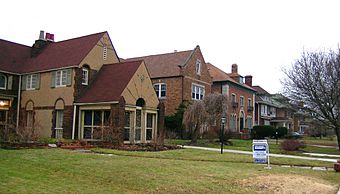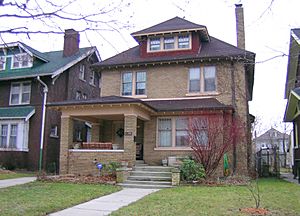Boston–Edison Historic District facts for kids
|
Boston–Edison Historic District
|
|

Homes on West Boston Boulevard
|
|
| Location | Bounded by Edison Ave., Woodward Ave., Linwood Ave., and W. Boston Blvd. Detroit, Michigan, U.S. |
|---|---|
| Area | 256 acres (104 ha) |
| Architectural style | Colonial Revival, Late 19th and Early 20th Century American Movements, Late 19th and 20th Century Revivals |
| NRHP reference No. | 75000965 |
Quick facts for kids Significant dates |
|
| Added to NRHP | September 5, 1975 |
The Boston–Edison Historic District is a special neighborhood in the middle of Detroit, Michigan. It's home to over 900 houses built on four main streets: West Boston Boulevard, Chicago Boulevard, Longfellow Avenue, and Edison Avenue. These streets stretch from Woodward Avenue in the east to Linwood Avenue in the west. It's one of the biggest historic neighborhoods for homes in the entire country!
This district is surrounded by other important places like Sacred Heart Major Seminary to the west and the Cathedral of the Most Blessed Sacrament to the east. The Boston–Edison area was officially recognized as a Michigan State Historic Site in 1973 and added to the National Register of Historic Places in 1975.
Contents
Famous People and Community
Many well-known people from Detroit have lived in the Boston–Edison neighborhood. These include important figures like labor leader Walter P. Reuther, famous boxer Joe Louis, and the founder of Motown Records, Berry Gordy.
Other notable residents include baseball players Harry Heilmann and Dizzy Trout from the Detroit Tigers, and Michigan governor Harry Kelly. It's a place where many different kinds of successful people chose to live.
The neighborhood also has the oldest continuous neighborhood association in Detroit, called the Historic Boston–Edison Association. It was started way back in 1921! This shows how much the residents care about their community. The district received its historic status from different groups between 1973 and 1975.
The neighborhood is home to both Black and White residents, and people from many different jobs and careers own homes here.
Amazing Architecture
The houses in Boston–Edison are known for their beautiful and varied designs. Here are some examples of the famous homes you can find there:
| Name | Image | Year | Location | Style | Architect | Notes |
|---|---|---|---|---|---|---|
| Walter O. Briggs House |  |
1915 | 700 West Boston Boulevard | English Manor style | Chittenden and Kotting | This house was built for Walter O. Briggs. He founded a company that made car bodies and also owned the Detroit Tigers baseball team. |
| James Couzens House |  |
1910 | 610 Longfellow Avenue | Tudor Revival | Albert Kahn | This house belonged to James Couzens, who was an important early investor in the Ford Motor Company. He later became the mayor of Detroit and a U.S. Senator. |
| Charles T. Fisher House |  |
1915 | 670 West Boston Boulevard | Tudor Revival | George D. Mason | This is the biggest house in the Boston–Edison Historic District, covering about 18,000 square feet. It was built for Charles T. Fisher, who was the president of the Fisher Body car company. |
| Henry Ford House |  |
1908 | 140 Edison Avenue | Italian Renaissance Revival | Malcomson, Higginbottom and Clement | This was the home of Henry Ford and his wife Clara. They moved in the same year the famous Model T car started being made. They lived here until 1914. |
| Berry Gordy House |  |
1917 | 918 West Boston Boulevard | Italian Renaissance Revival | This large mansion was bought in 1967 by Berry Gordy, who founded Motown Records. It's sometimes called the Motown Mansion. | |
| S. S. Kresge House |  |
1914 | 70 West Boston Boulevard | Mediterranean villa | Meade and Hamilton | This house was built for Sebastian S. Kresge, who started the S. S. Kresge Company, which later became K-Mart. His house is on the largest property in the neighborhood. |
| Benjamin Siegel House |  |
1914 | 150 West Boston Boulevard | Italian Renaissance | Albert Kahn | This house was built for Benjamin Siegel, who owned a big clothing store for women. It's made entirely of limestone and has a very balanced design. |
History of the Neighborhood
|
Henry Ford House
|
|
|
U.S. Historic district
Contributing property |
|
 |
|
| Architect | Malcomson, Higginbotham and Clement |
|---|---|
| Part of | Boston–Edison Historic District (ID75000965) |
The land where Boston–Edison now stands was first owned by John R. Williams in 1822 and Thomas Palmer in 1828. Over time, these lands were bought by other families, including the Joy and Newberry families, and Edward W. Voigt.
In 1891, Edward W. Voigt had a smart idea. He saw that Detroit was growing north, so he planned out a new area called the Voigt Park subdivision. He created wide streets and set rules for building houses. This helped create the special look and feel of the Boston–Edison neighborhood. Other families, like the Newberrys and Henry B. Joy, also developed parts of the area later on. By 1915, all these areas were part of the City of Detroit.
The first homes in Boston–Edison were built in 1905, and most of the houses were finished between 1905 and 1925. Each house in the neighborhood is unique, with different styles like English Tudor, Greek Revival, and Italian Renaissance. Even though the styles are different, the houses generally have similar rooflines and are set back from the street in the same way. This creates a beautiful, suburban feel.
Early Residents
One of the most famous early residents was Henry Ford. In 1907, he built a large brick and limestone house on Edison Avenue. He and his wife, Clara, lived there until 1915. While living in Boston–Edison, Henry Ford changed American industry forever with his Model T car and new ways of making things. He even built a machine shop above his garage for his son Edsel to encourage his interest in car design. There's a special historical marker in front of his house today.
Henry Ford was just the first of many important people from the car industry to live here. His early business partners, James Couzens and Horace Rackham, also built homes nearby. Other car pioneers like Walter Briggs Sr. and several of the Fisher brothers (who founded Fisher Body) also chose Boston–Edison as their home.
Many other important Detroit business people lived in the neighborhood too. These included Sebastian S. Kresge (who started the Kresge store, which became Kmart) and Benjamin Siegel (who owned a big clothing store). Famous people like conductor Ossip Gabrilowitsch, Detroit Tigers owner Frank Navin, and baseball star Ty Cobb also lived in or very close to Boston–Edison.
During the early years, three main things made the community special. First, people who worked together often lived close to each other, like Henry Ford and his team. Second, many family members lived near each other. For example, several of the Fisher brothers and Benjamin Siegel's relatives lived in the neighborhood. Third, the Henry Ford Hospital was built nearby in 1915, and many doctors chose to live in Boston–Edison.
Schools in the Area
Students living in the Boston–Edison district attend schools in the Detroit Public Schools system. For elementary school, different parts of the neighborhood are served by Durfee K-8, Loving, and Thirkell elementary schools. All middle school students go to Durfee K-8. For high school, all residents are zoned to Central High School.
See also
 In Spanish: Distrito Histórico de Boston-Edison para niños
In Spanish: Distrito Histórico de Boston-Edison para niños




